ISFAHAN PROVINCE
ISFAHAN CITY
The City of turquoise domes
10 ISFAHAN MOST POPULAR CITIES
| Rank | City | Population |
|---|---|---|
| 1 | Isfahan | 1,961,260 |
| 2 | Kashan | 304,487 |
| 3 | Khomeyni Shahr | 247,128 |
| 4 | Najafabad | 235,281 |
| 5 | Shahin Shahr | 173,329 |
| 6 | Shahreza | 134,952 |
| 7 | Fuladshahr | 88,426 |
| 8 | Aran o Bidgol | 65,404 |
| 9 | Nain | 27,379 |
| 10 | Natanz | 14,122 |
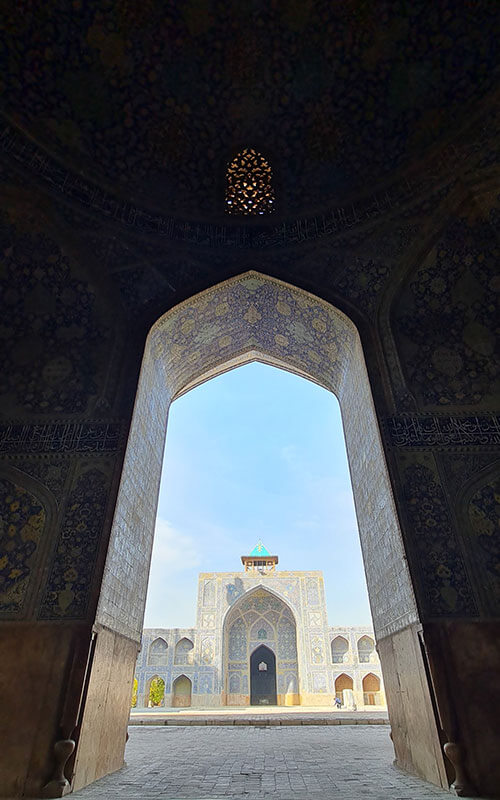
A Brief History
Esfahan, often called Isfahan, is the capital and largest city of Esfahan Province in western Iran. Esfahan is about 210 miles (340 kilometers) south of Tehran, on the north bank of the Zyandeh River, at a height of around 5,200 feet (1,600 meters). The Seljuq Turks (11th–12th century) and the Persian Safavid dynasty (16th–18th century) were the first to prosper in Esfahan. The city is one of the most prominent architectural centers in the Islamic world, in addition to being an important regional and provincial capital (of Esfahan province). Maydan-e Emam (Persian: "Imam's Square"; formerly Maydn-e Shah, "Royal Square") in Efahn was declared a UNESCO World Heritage site in 2016.
A settlement named Gabae (later renamed Gay in Middle Persian and Jayy in Arabic) can be dated back to the Achaemenid dynasty (559–330 BCE) at the site of present Efahn, although little is known about the area before the Ssnian dynasty (c. 224–c. 651 CE). Queen Shushan-Dukht, the Jewish consort of Yazdegerd I (reigned 399–420), is supposed to have founded a Jewish colony at Yahdiyyeh (meaning "town of the Jews") in the 5th century. (Nebuchadrezzar has also been credited with founding the settlement, but this appears less credible.) The Shahrestan Bridge, which spans the Zayandeh River a short distance southeast of the city, was built during the Sasanian era; however, only the piers survive.
When the temporal authority of the Abbasid caliphs diminished in the 10th century, Esfahan prospered under the Persian Buyid (Buwayhid) dynasty, which rose to power and governed most of Iran. Toghril Beg, the Turkish conqueror and founder of the Seljuq dynasty, made Esfahan the capital of his holdings in the mid-11th century, and the city rose in size and magnificence under his legendary grandson Malik-Shah I (reigned 1073–92). In those days, the city's center was a square or rectangle located to the north of the Maydan-e Shah, which would subsequently become the city's main courtyard. On the north, it was surrounded by the Great Mosque of Esfahan (Masjed-e Jami), which is still one of the city's architectural highlights.
Climate and weather
Summers in Isfahan are hot, arid, and clear, while winters are bitterly cold, dry, and mainly clear. The temperature normally ranges from 24°F to 98°F throughout the year, with temperatures rarely falling below 17°F or rising over 103°F. Early June to early September is the best time of year to visit Isfahan for hot-weather activities, according to the beach/pool score.
From May 29 to September 18, the hot season lasts 3.7 months, with an average daily high temperature of over 88°F. July is the hottest month in Isfahan, with average highs of 97°F and lows of 67°F. From November 23 to March 2, the cold season lasts 3.3 months, with an average daily high temperature below 59°F. January is the coldest month in Isfahan, with average lows of 25°F and highs of 49°F.
When to Go to Isfahan?
All travelers say that knowing the weather prediction for their location is one of the most important things to know before going on a trip since it helps them pack properly. You need also to know the days in your destination to design a day-by-day tour. As a result, because Isfahan is one of the must-see towns in Persia, weather information for Isfahan is quite useful for all visitors to Iran.
Early April to mid-May is the finest time to visit Isfahan because spring is at its most beautiful at this time. As a result, the weather in Isfahan is pleasant at this time, and the city's gardens are lush with green trees and vibrant flowers. You can also go for a walk along the lovely Zayandehrood seasonal river or through old bridges like Sio-Se Pol and Khaju. Furthermore, neither the hustle and bustle of Nowruz (March 20th to April 1st or later) nor the severe summer heat will trouble you during this time. In addition, you can visit the deserts near Isfahan in the spring, such as the Varzaneh Desert (Khara Desert).
From September through early November, the weather in Isfahan is quite pleasant. The vibrant and warm ambiance of the gardens, as well as the fallen yellow leaves of Charbagh Street, add to the appeal of this city in autumn, making your vacation to Isfahan even more memorable. Furthermore, in November, when the weather in those areas is pleasant, you can visit the deserts surrounding Isfahan. As a result, you can visit Isfahan in the autumn, which is not only gorgeous but also less busy.
Isfahan, on the other hand, is a winter wonderland for skiers. As a result, from January to March, you may go skiing in the mountains around Isfahan.
June, July, and August are the least popular tourist months in Isfahan due to the hot and dry weather. Summer, on the other hand, has the lowest travel costs.
Recommended month for traveling to Isfahan Province
APRIL - MAY

Where to Go in Isfahan?
First of all, you should get some information about Isfahan cities. There are countless places that you can visit but here is the "you must see it" list:
Isfahan
The province of Isfahan, located in the heart of Iran, is a country of gorgeous structures, well-designed carpets, and one-of-a-kind artworks. For centuries, Isfahan had served as Iran's capital. The city of Isfahan is merely one of the province's major cities.
Kashan
You should travel to Kashan and see another section of the province, where small lanes and clay dwellings reveal a different side of the province's beauty and tranquility. The smell of Damascus Roses fills the room. You should go to Slk to be enthralled by its 8,000-year history. Furthermore, Abyaneh is a site where people still dress in 1000-year-old clothes and talk in their ancient dialect.
Natanz
Natanz is a familiar name to every lover of history and nature. A green jewel in the heart of the desert lands that hides a world of history in its heart and rests on the slopes of Mount Vulture. In the middle of the city of old trees, you must visit the Natanz Grand Mosque. A mosque with a nave, a dome, and a special minaret, also houses a monastery and the tomb of Sheikh Abdul Samad Natanzi.
Multiple wonders of the historical neighborhood are planted among green and old trees, Saraban Park, open dome, fire temple, Hanjan village with castles and aqueducts and historical gardens, Sarshak Mosque, Qala Kohab Caravanserai, Matin Abad Desert Eco Camp, Mir Mosque, Abyaneh village, and village Dehabad is one of the other sights of the historical city garden of Isfahan province. Qasr Jahan Hotel, Tavaslian House Ecotourism Resort, Matin Abad Desert Ecocamp, Viona Abyaneh Hotel, Harpak Ecotourism Resort, and Ryan Resort are among the accommodations in and around Natanz.
Golpayegan
An old four-season county, located in the center of the country and has many historical attractions. The most famous local food in Golpayegan is Kebab, tourists of Iran may know about this food but it must be noted that the kebab which is roasted in this city is something else.
Naein
Perhaps the idea of such a city in the middle of the vast desert plain was so far from expected that it caused Naein to be called the jewel of the desert. Naein is one of the oldest cities in Iran and is more than 3000 years old. In this historical city, you must visit the Grand Mosque, the historical and old market of Naein, Naranj Castle or Narin Qala, the historical neighborhood of Mohammadiyeh with Ashourgah Castle and Abafafi workshops dug in the heart of the mountain, Rigareh Water Mill, the beautiful house of Pirnia and the desert museum located in Visit its halls and rooms, Fatemi House, Baba Abdullah Mosque, Bagh Mosalla, Sepro Fire Temple, historical caravanserais of Nistanak and Balabad, historical and beautiful Imami house and water reservoirs and numerous shrines of this city.
Koohpayeh
Koohpayeh is a small town 65 km from Isfahan, which is mentioned in history books as the city of Weir, which means intelligence and wisdom. This small town has a mosque that is several hundred years old and is a relic of the Seljuk period.
Shah Abbasi Caravanserai, a relic of the Safavid period, which has now been completely renovated, next to the Talar Mosque, Ghadmagah Mosque, the beautiful village of Zafra with its Grand Mosque and its wooden pulpit next to the eye-catching nature, Nilab, the old bazaar, the brick mosque And Mahan tourist village at the foot of Marshanan mountain is another spectacular attraction of this small and old city. If you want to stay at the foot of the mountain, be sure to visit the Shah Abbasi Caravanserai and spend a night in the 450-year-old caravanserai.
Aran-e Bidgol
Aran and Bidgol is one of the most desirable cities in Isfahan province. A historic city with a long history and a distant past that has been full of many ups and downs. A city with historic neighborhoods and beautiful gardens that are full of shrines, mosques, baths, and historic reservoirs. In the meantime, we must visit the Imamzadeh of Mohammad Hilal Ibn Ali (AS), the historical complex of Ghazi with water storage, Hosseinieh, Imamzadeh, bazaar, houses and historical mosque of Ghazi, Naghshineh mosque, Karshahi castle, Sizan castle, Bazaar mosque, and ancient area Wiggle.
Niasar
Niasar is one of the oldest cities in Iran, which is located twenty kilometers from Kashan. A very green and beautiful city that is famous for having a pleasant climate. Niasar is also famous for its lush gardens and flower gardens. One of the most important sights of Niasar city is the four arches left from the Sassanid period, which indicates the antiquity of this region.
In addition to the four-arched Sassanid fire temple, baths, and water mills belonging to the Safavid period, the historic promenade of the Garden Hall and the historic pavilion between them, Rais Cave or Weiss hole, which is a completely handcrafted Alexandria spring, and the famous Niasar waterfall are other beautiful sights of this city. If you are interested in rose-picking ceremonies, be sure to visit Niasar and witness this traditional and very attractive ceremony closely in the traditional workshops of this city. The only option for you to stay in Niasar is the Green Niasar Hotel, but if you are interested in staying in eco-tourism resorts, get to Kashan.

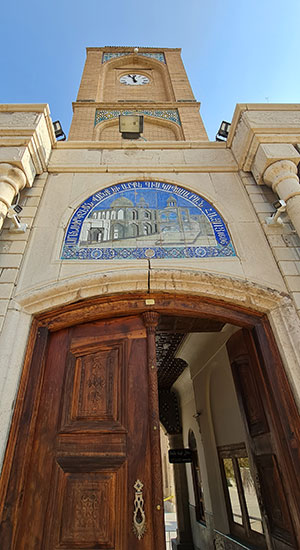
Vank Cathedral
This is Isfahan's largest and most beautiful cathedral, located in the Jolfa neighborhood. The interior decorating comprises oil paintings based on Italian masterpieces depicting various aspects of Jesus Christ's life.
Sialk Hill of Kashan
This ancient hill can be found 3 kilometers south of Kashan. This area's civilization dates back to 4500 BC, according to clay dishes discovered in the area. Clay tablets from the Elamite period have also been uncovered in the vicinity. Two graveyards, commonly referred to as A and B, have been uncovered near Sialk's central hill. Iron weapons, swords, lances, and piping dishes were discovered during the excavations. Objects discovered in graveyard A date from 2000 BC, while those discovered in graveyard B date from the early first millennium or late second millennium BC.
Jameh Mosque
Most international tourists who visit Esfahan believe that they have not seen a more magnificent location in Iran than the Jame Mosque of Esfahan and that a trip to Esfahan would be incomplete without a visit to this monument. The Esfahan Masjed-e Jame, or Esfahan Jame Mosque, had a huge influence on mosque architecture in Iran and Central Asia. From the eighth century (specifically 771) until the end of the twentieth century, the main building, which is today utilized as a mosque, has undergone continuous construction, reconstruction, extensions, and repairs. The iwans, which are open spaces with a view of the sky, are one of the mosque's most remarkable features. The mosque contains four iwans, two of which are facing each other and the largest facing the Muslims' Qibla in Mecca.
Hasht Behesht Palace
Shah Soleyman of the Safavid dynasty lived in this palace, which was built on the king's orders in Isfahan's enormous Hasht Behesht garden. The outside title work with motifs of birds and animals is part of the palace's ornamentation.
Fin Palace and Garden of Kashan
Fin castle and garden is a luxury structure in Isfahan province, located 6 kilometers south of Kashan. This is a typical palace from the Safavid era (1501-1736), with minor additions made during the Zand (1751-1794) and Qajar eras (1789-1925). The significance of the garden is determined by its location and irrigation system. In the 17th century, Amir Kabir, the Iranian prime minister at the time of Nasser ad-Din Shah Qajar, was slain in the bathroom.
Khaju Bridge
On the Zayande Rd River, this bridge was constructed. The construction of this bridge began in the late Timurid dynasty and continued into the 16th century CE. However, Shah Abbas II of the Safavid dynasty ordered it to be completed (1501-1736). The bridge's rooms are embellished with murals and tile work. A separate structure called Biglarbeigi was built in the center of the bridge as a temporary residence for the monarch and his family.
Borujerdis House
In Kashan, the mansion is considered one of the best examples of Iranian architecture. The home was constructed in the 18th century CE. Clay, bricks, and mud were utilized in the construction of this home. Plasterwork, tile work, mirror work, and paintings are among the decorations.
Naghsh-e Jahan (Meidan Emam) Square
It was erected in the direction of King Abbas I of the Safavid dynasty (1501-1736) in a garden called Naghsh-e Jahan and is one of the largest squares in the world. Many prominent buildings, such as the Shah (Emam) Mosque, Sheikh Lotfollh Mosque, and the Alighapu Palace, were built around the area. The area was used as a public gathering place during the Safavid period for various rituals such as soldier's parades, polo matches, festivities, and plays. This square is included as a UNESCO World Heritage Site.
Niasar Temple
This temple was discovered by Roman Guirshman, a French archeologist, in the city of Kashan.
Abyaneh Village
This town, which is one of Isfahan's most well-known mild climate villages, is located 28 kilometers from Natanz in the foothills of the Karkas Mountain. The social structure, architecture, and inhabitants' commitment to preserving their historic customs and culture are all fascinating aspects of this community.
Zayande River
Zayanderud is one of Iran's major rivers, and its name means "birth giver," implying that it has given life to various sections of the country. Other names for this river have been found in various sources, including Zenderud (living river), Zendrud, Zarrinrud (golden river), and Zarrinerud.
Zayanderud came into being as a result of the fusion of several sources. The river's major source is on the hillsides of Bakhtiari's Zardkuh, which lies between the provinces of Isfahan and Lorestan. Other springs, such as Kuhrang, Cham Darreh, and Dimeh, also pour into Zayanderud, and after passing through the Zagros Mountains, this raging river proceeds east and approaches the country's core regions.
The main reason for Zayanderud's particular popularity is undoubtedly owing to its passage through Isfahan and its historical bridges. Although other towns have built bridges over Zayanderud, the variety and beauty of Isfahan's ancient bridges have linked the city's name to the name of Zayanderud. These antique bridges date back to the Safavid dynasty and are almost 400 years old. There are, however, other noteworthy bridges erected across the river from Isfahan. The Zaman Khan Bridge in Saman is one of the most well-known bridges on the Zayanderud River in Isfahan Province.
Si-o-Se Pol and Khaju Bridge
two medieval bridges that are currently among Isfahan's greatest historical attractions are noteworthy among Zayanderud's most well-known bridges. Si-o-Se Pol and Khaju Bridge not only attract a large number of Iranian and foreign tourists each year but are also regarded as a promenade for Isfahan residents. Other historical bridges in Isfahan are Shahrestan Bridge, Marnan Bridge, and Choobi Bridge.
The majority of Zayanderud's path is located within Isfahan, on two sides of which there are some green spaces and resorts. In Saman city, there are also several gardens on both banks of the river, where various tourism enterprises have been built in recent years.
The passage of Zayanderud through many provinces has spawned new hobbies such as rafting (boating on raging water), one of the most accessible of which can be found along the Zaman Khan Bridge in Saman city.
Apart from tourism, Zayanderud is so important to Isfahan's and adjacent provinces' water supply that life without it is unthinkable.
Si-o-Se Pol bridge
The bridge's original name was Allah-Verdi Khan Bridge. However, it is better known as Si-o-se-pol, which is the Zayanderud River's largest bridge. During the Safavid Dynasty, the bridge was constructed over 400 years ago.
The bridge, which is one of the most well-known instances of Safavid construction, was created to act as both a bridge and a dam. The bridge was also built to connect the wealthy district of mansions on one side with the Armenian neighborhood of New Julfa on the other.
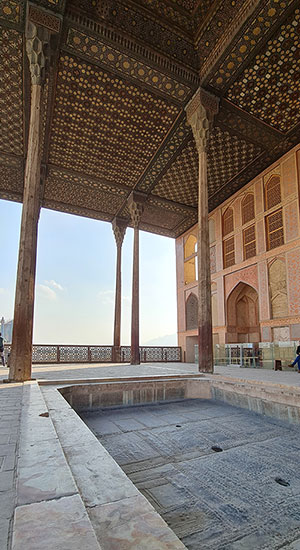
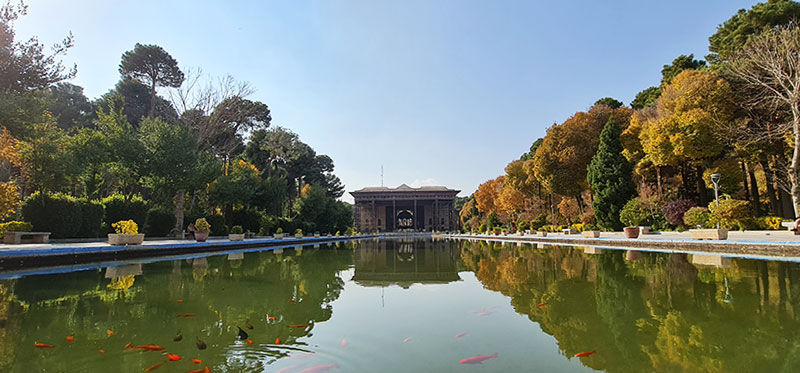
Chehel Sotun Palace
The palace was built in Isfahan's Chehel Soton Garden during the reign of the Safavid dynasty's King Abbas I. (1501-1736). Paintings, mirror work, tile work, and goldwork products are among the embellishments. Because numerous columns are utilized in the building, it is termed Chehel Soton, which means "forty column structure."
Rose Water Extraction in Ghamsar
Ghamsar, a city near Kashan, is known for its rosewater extraction industry. This national ritual takes place every year in May, June, and July. The majority of workshops have been established between Ghamsar and Kashan. The liquid Rose essence is exported to France and Bulgaria, which are the world's top perfume makers.
Let's Go to ISFAHAN, KASHAN - MAY
Rose Water (GOLAB) Extraction Ceremony
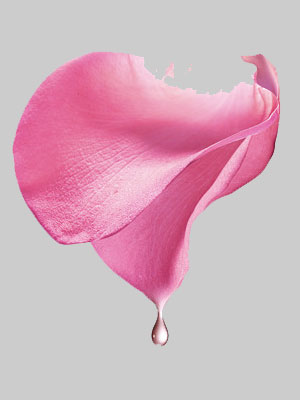
Top Dishes in Isfahan
Food is one of the most crucial and exciting aspects of any journey. Iran has one of the world's most diverse cuisine choices. In Iran, each city has its specialty cuisine. These cuisines have a long history in their respective communities and regions. As a result, each Iranian province and city is known for one or more unique dishes. Isfahan, sometimes known as the "Half of the World," is one of Iran's most intriguing cities. Isfahan is not only famed for its ancient sites, but also for its traditional and fragrant cuisine, which can make your vacation much more enjoyable. Here's a list of some Isfahan specialties. This list includes a variety of meals such as Ash (Persian soup) and others.
Ash is a type of Iranian cuisine that resembles soups but is quite distinct. Ashes have a wide variety of local veggies and beans. In Iran, there are a lot of ashes. Ispahan, too, has its Ashes.
Biryani or Beryanee
This beryouni is without a doubt the most well-known food in the world. Biryani is a dish made of sheep's pluck, lamb, spices, onion, salt, cinnamon, pepper, and turmeric that tastes like a hamburger. In Isfahan, these delicacies are prepared in a unique frying pan of a specific size and shape, but anyone can cook them in a regular pan. Cinnamon, almonds, pecans, and sesame are commonly used in their preparation. Biryani is always served with Sangak bread and a fresh vegetable side dish. Of course, the chief will frequently serve Ab-Gosht (meat soup) with floating bread pieces.
Kaleh Joosh
Kaleh josh is a nutrient-dense and easy-to-prepare dish. This quick and easy meal is commonly prepared in the province of Esfahan. The chef prepares this meal with just natural ingredients like curd, dried mint, walnuts, oil, salt, pepper, and specific spices.
Halim Bademjan
This cuisine is prepared similarly to Kaleh josh throughout Iran; however, it is primarily prepared by Esfahan residents. Meat, dried mint, eggplant, white beans, whey, salt, and pepper are used to prepare these dishes.
Gheymehrize Nokhodchi
Gheymehrize Nokhodchi is another Esfahan delicacy. They utilize beef, chickpeas, fried onions, dried mint, and spices to prepare this dish. Then, after kneading and shaping the dough into large balls, they immersed them in a liquid including tomato paste and cooked onion until they were completely shredded. Nokhodchi can be gheymehrized with rice or bread.
Taskabab
Vegetarians and non-vegetarians alike will enjoy this classic Esfahani food. It's also prepared in other parts of the country. Mutton, onion, carrot, potato, quince, oil, salt, and pepper are the main components of Taskabab. Bake kababs with the ingredients listed above, then add tomato paste and water to the mix. Taskabab can also be served with rice or bread.
Ash-e-Shorba
This dish includes a combination of pork, beans, and peas, as well as a variety of vegetables, seasoned with local spices. The natural ingredient is the most significant feature of this dish. Various types of soups(Ash) or ash are cooked in various parts of Iran. Each region has a distinct soup. Vegans will appreciate these varieties of soups.
Ash-e-somagh (sumac soup)
The Esfahan province's local cuisine is ash-e-somagh. Meat, flour, rice, sumac, onions, and various veggies are among the ingredients in this dish.
Khoresht Mast
It may sound similar to Sholeh Zard, an Iranian desert, but don't be fooled. Esfahan's Khoresht Mast is a delectable dish. Mutton, yogurt, salt, sugar, water, turmeric, pistachio, almond, and barberry are among the ingredients.
Kachi
Kachi is a popular Iranian delicacy that can be found all across the country. Flour, almonds, and pistachios make up this dish.
Halim with meat and lentils
Different forms of Halim can be found in Esfahan. Each one has the potential to make your journey more enjoyable. Meat, onion, species, and lenses are used to prepare this cuisine, which is eaten in the morning or during the day. I recommend that you taste this meal, which is produced by superb expert chefs, during your visit to Esfahan.
Top Souvenirs of Isfahan
There are two types of Esfahan souvenirs and handicrafts: culinary souvenirs and Isfahan handicrafts. Nobody can say which category is superior. Edible souvenirs are less expensive than handicrafts, but they have a shorter shelf life. As a result, you can buy one or both of them. One of the most enjoyable aspects of your trip is shopping for mementos. We share lovely recollections of our journey with our friends and loved ones by purchasing souvenirs. maybe even a memento to remind us of those days and experiences. You may buy Isfahan souvenirs and handicrafts in a variety of ways in Esfahan. Because of their engraving and enamel work, Esfahan handcraft gifts are quite appreciated around the world. In addition, this art has a high export rate in Iran. In this section of our Iran travel blog, we will expose you to the best Isfahan souvenirs and handicrafts. So please stick with us. Isfahan is one of Iran's most populous provinces. This city is home to Iran's most well-known tourist attractions. Many foreign tourists visit Iran to see these fascinating sights, and if you ask any foreign traveler, they will tell you that Isfahan is their favorite city. You may find the tastiest candies, delectable desserts, and cookies, as well as the best handicrafts that are one-of-a-kind and cannot be found anywhere else.
Isfahan Edible souvenirs
Gaz
Isfahan Gaz has a long and illustrious history dating back several centuries. Iranian kings provided Gaz to other world kings centuries ago as a gift. It is one of the most important Esfahan souvenirs and handicrafts, dating back to the era of the Safavids.
Poolaki
Poolaki is one of the most famous sweets and souvenirs in Esfahan, after Gaz. Not just among tourists, but also among Iranians, this product is immensely popular. It belongs to the sweets category.
Fereydoun Shahr honey
You may not be aware that Fereydoun Shahr honey from Isfahan is among the best in the country. It is high-quality honey with various medicinal effects due to the variety of herbs found in the area.
Joz-e Qand
One of the most expensive Isfahan souvenirs and handicrafts is this native delicacy. This traditional dessert is created in various of our country's cities. They use a native fruit called the Alag, which is a sort of peach, to make Joz-e Qandi.
Sohan Asali (honey Sohan)
Honey, butter, sugar, almonds and pistachios, water, and saffron are used to make a delectable and unique dessert that can be purchased in Esfahan. This sweet can be found in a variety of formats on the market.
Isfahan handicrafts souvenirs
Isfahan is known as the birthplace of Iranian handicrafts. This city's handicrafts have a lengthy history and are well-known not just in Iran but also around the world. The best Iranian artwork may be purchased in Isfahan's Naqsh-e Jahan area and the old market. Here are some of the Isfahan souvenirs and handicrafts that you can purchase as unique gifts in this city.
Mina Kary (vitreous enamel)
The birthplace of vitreous enamel is Esfahan. This art has evolved into one of Isfahan's most important handicrafts, and it is now a part of Iranian culture. All tourists are enamored with this lovely artwork and purchase it as gifts and souvenirs. The art of applying color to regularly used metals is known as vitreous enamel. Of course, this technique was utilized to design a range of ceramics as well as a variety of metal vessels made of gold, silver, brass, copper, and bronze.
Khatam Kary
In Esfahan, another handcraft used by talented artists in the wood industry is Khatam Kari. Khatam Kari, which dates back to the Safavid era, is also popular in Shiraz. The goal of this craft is to make attractive geometric shapes by putting together little pieces and triangles of wooden shapes. They also employ camel or horse bones, as well as gold, silver, aluminum, and brass, as well as ebony wood, jujube, orange, and betel.
Qhalam Kary
Cyan tiles are the oldest tiles in Esfahan, and they were used to embellish ancient inscriptions on Seljuk period minarets. Ensign tiles for the exterior of buildings and mosques are created and utilized in seven colors and mosaics in Esfahan, in addition to ordinary building tiles. Tiled dishes, pots, and a variety of other items are also manufactured with a variety of designs, most of which are geared toward export.
Qholab Dozi
Esfahan Ladies perform embroidery, crochet, and other types of this art. Handmade textiles in various hues and silk threads serve as the foundation for this stunning work of art. Some undertake simple embroidery, while others do it with more intricate designs that raise the price of the final product.
Malileh Sazi
Malileh Sazi is so well-known in Esfahan that local silversmiths create and sell sets of necklaces, earrings, bracelets, and pins.
Qalam Zani
This is one of Esfahan's most well-known industries, and it's done on trays, pots, dishes, plates, and photo frames, among other things. They may be found in Chaharbagh Street and Naqsh-e Jahan Square businesses. One of Esfahan's most well-known handicrafts is Qalam Zani. Artists from Esfahan engrave, grate, and mark a wide range of products, including pots, trays, decorative items, samovars, plates, and boxes. They create stunning designs and priceless works that draw every visitor's attention to themselves and entice them to purchase them as Esfahan souvenirs and handicrafts.
